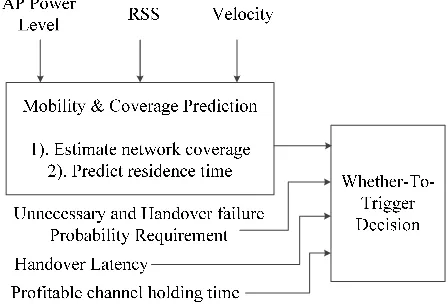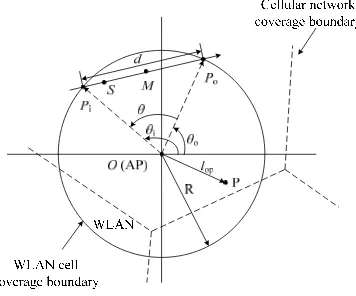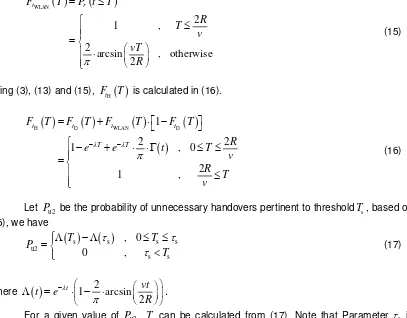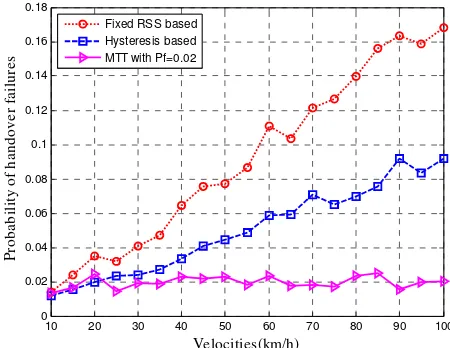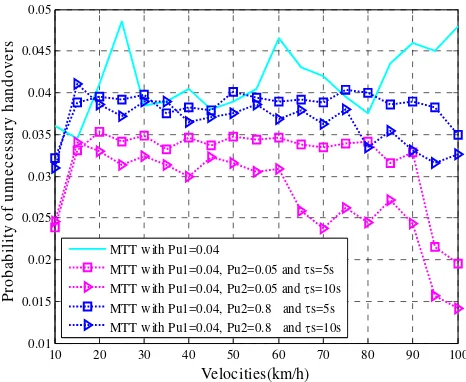DOI: 10.12928/TELKOMNIKA.v12i1.1618 163
A Threshold Based Handover Triggering Scheme in
Heterogeneous Wireless Networks
Liming Chen*1, Qing Guo1, Zhenyu Na2, Kaiyuan Jiang1 1
Communication Research Center, Harbin Institute of Technology, Harbin, China 2School of Information Science and Technology, Dalian Maritime University, Dalian, China
*Corresponding author, e-mail: {chenliming, qguo}@hit.edu.cn
Abstract
The widespread popularity of Wireless Local Area Network (WLAN) is recognized as an effective approach to complementing cellular networks for the high data rate and cost effective connectivity delivered to mobile users. Efficient handover and offloading schemes for integrated WLAN and cellular networks, referred to as Heterogeneous Wireless Networks, have thus attracted lots of attentions from both academia and industry. This paper proposes a novel Multiple-Threshold based Triggering (MTT) scheme for Cellular-to-WLAN handover control. Aiming at minimizing the probability of handover failures and unnecessary handovers, three thresholds are calculated based on a variety of network parameters such as system performance requirements, radius of the WLAN coverage, user mobility and handover delays. The thresholds are then compared against the predicted user residence time and estimated channel holding time inside WLAN to make vertical handover decisions (VHDs). Simulations were carried out to evaluate the effectiveness of MTT and results show that MTT minimizes handover failures and avoids unnecessary handovers in integrated cellular and WLAN networks, thus providing satisfactory Quality of Service (QoS) to users and improving system resource utilization.
Keywords: integrated networks, vertical handover decision, handover failures, unnecessary handovers, QoS
1. Introduction
One of the most apparent challenges in mobile broadband networks will be the handling of the predicted increase in data traffic volume, which is doubling annually in the forthcoming years, with 26 times more mobile traffic in 2015 than in 2010 and reaching 6.3 exabytes in 2015 [1-3]. This growing consumer demand for higher data rates as well as seamless access to various communication services anywhere and anytime is accelerating the technological development towards the integration of various wireless access technologies, i.e., Heterogeneous Wireless Networks [3]. Wireless Local Area Networks (WLANs), originally designed for laptops and now often complementing the cellular networks in serving handheld devices, are embracing unprecedented popularity for its superior data rate and cost effective connectivity delivered to mobile Terminals (MTs). Mobile Network Operators (MNOs) are turning to WLANs to offload some of the exponentially increased subscriber data traffic such that the demand on both the radio access network and core network are reduced [4-7]. However, to fully exploit the advantages offered by the WLAN integration and data offload, intelligent and efficient vertical handover decision (VHD) schemes should be carefully made to guarantee the Quality of Service (QoS) while maximizing the usage of the available WLAN connectivity.
In the existing technical literature, many related studies on VHD have been reported [3, 8-19]. In [8], a WLAN to 3G handover decision algorithm was presented based on comparison of the current received signal strength (RSS) and a dynamic RSS threshold when a mobile terminal is connected to a WLAN access point (AP). In [11], based on traffic loss performance modeling, a speed-sensitive call admission control scheme was proposed to avoid unnecessary and frequent handover between cells for multiservice traffic, thus improving the call-level loss performance and reducing unnecessary handovers. In this and also most of the other VHD schemes such as [19], handover from the cellular network to the WLAN is initiated once the MT enters the WLAN to utilize the huge inherent capacity and low cost connectivity, i.e., WLAN if coverage.
MT’s trajectory is close to the boundary of the WLAN coverage, the MT might have to switch back to the cellular network immediately after completing the handover to the WLAN. Or, if the handover process has not been completed before the MT leaves the WLAN, connection breakdown inevitably occurs. Yan et.al in [18] proposed an efficient triggering scheme targeting at this problem and achieved satisfactory results concerning failed and unnecessary handovers, but in some other cases an MT may terminate its connection to the AP immediately after handing over into the WLAN, leading to the incapability for the operator to make profit upon this handover and resulting in unnecessary cost.
In view of the above deficiencies discussed and extending the work in [18], a novel VHD scheme named Multiple-Threshold based Triggering (MTT) is proposed. Different from [18], MTT takes into consideration both the time an MT is expected to spend within the WLAN and the time it is expected to hold the channel, i.e., channel holding time. Adopting a variety of network parameters such as performance requirements, radius of the WLAN coverage, user mobility and handover delays, MTT first calculates three thresholds pertinent to the probability of handover failures and unnecessary handovers. The thresholds are then compared against the predicted user residence time and estimated channel holding time inside the WLAN, respectively. For the connections that fail to meet the requirements of the thresholds, their handover requests will be rejected, thus avoiding unnecessary handovers and enabling more efficient VHDs from cellular networks to WLANs.
The remainder of this paper is organized as follows: Section II discusses the coverage and traffic models assumed in this work. Section III spells out the details of our proposed MTT scheme. Section IV provides performance evaluation and Section V concludes the paper.
2. System Models
In this section, coverage and traffic models that will be used in MTT scheme are built. MTs are assumed to be multi-model, i.e., having both cellular and WLAN interfaces, which is reasonable due to the current popularity of smart handheld devices. The architecture of tight coupling is considered for the integration of WLAN and cellular networks, in which a common core and most network functions such as mobility and resource management are shared by the two networks, with billing managed centrally. Though the tight coupling may incur some extra networking units such as session-aware gateways, it could be considered in the long-term enhancement of operator’s network, which guarantees MNOs full control over subscribers as well as the ability to deliver any subscribed content when users are in WLAN.
Consistent with other literatures, we assume that the WLAN coverage has a circular geometry and our proposed MTT scheme also uses successive RSS measurements to predict the residence time in the WLAN. The propagation model adopted in the WLAN coverage is the commonly-used log-distance path loss model, according to which the relationship between
RSS
(in dBm), and the distance between AP and the MT at any point P inside the WLAN coverage can be expressed as:Tx ref
ref
.
PL 10 lg OP P
l
RSS P X
d
(1) Where RSSP is the RSS at point P ; PTx is the transmit power of AP; dref is the
distance between the AP and a reference point; PLref is the path loss at the reference point; lOP
is the distance between AP and P; is the path loss exponent; X is a Gaussian distributed random variable with a mean of zero and a standard deviation in dB.
D( ) 1 , 0.
T t
F T e T (3)
Note that
m
1
T
and tD denotes the average value of connection duration (the
unencumbered call duration with an exponential distribution and mean value Tm).
3. Multiple-Threshold Based Triggering (MTT) Scheme Description
The objective of proposed MTT scheme is to minimize the probability of handover failures and unnecessary handovers of MTs moving from cellular networks to WLANs, thus improving the overall network resource utilization and user experience. It consists of two units: Mobility & Coverage Prediction and Whether-To-Trigger Decision, as shown in Fig. 1.
3.1 Mobility & Coverage Prediction
MTT scheme relies on mobility & coverage prediction scenario as introduced in [18] to predict user residence time inside the WLAN, which is shown in Fig. 2.
Let Pi and Po be the entry and exit points to and from the WLAN coverage, M the middle point between Pi and Po,
d
the traveling distance of the user. By virtue of RSS measurements, we first calculate the radius of the WLAN coverageR
:Tx ref i
i
10 ref 10
P
P PL RSS OP
R l d
(4)
Then we choose one successive point S along the MT’s traveling trajectory, thus
Tx ref
10 ref 10
S P PL RSS
OS
l d
(5)
i i
i i
2 2 2
2 2 2
P M OM OP
OM SM OS
P M P S SM l l l l l l l l l
(6)
Further, let
v
be the speed of the MT, we have,
i
i i
WLAN
2
P M
s P
P S t l v
l v t t
(7)
By combining (4)-(7), tWLAN is expressed as
i i
i
2
2 2 2
WLAN 2
P S S P
P S
l RSS l RSS v t t t
v t t
(8)
Where
Tx ref
10 ref
= 10
P PL
l d
Note that, for the purpose of tractability, the M&C Prediction works under the following assumptions: 1). the entry and exit points are arbitrarily chosen on the circle of the WLAN coverage with equal probability; 2). the MT passes through the WLAN coverage along straight line trajectories.
3.2 Whether-to-trigger
The purpose of Whether-To-Trigger (WTT) is to calculate three thresholds based on a variety of network parameters, and compare them against the predicted MT residence time and estimated channel holding time to make vertical handover decisions. Here is the detail:
1) Handover failure related threshold: To minimize handover failures, WTT introduced a time threshold parameter Tf, according to which WTT will admit handover requests based on their predicted residence time in the WLAN, thus preventing them from being dropped during
According to [18], for a specific value of handover failure probability Pf(0Pf 1), Tf can be determined as
f i f
2 sin
2
R
T P
v
(9)
Where
arcsin 2vt t
R
2) Unnecessary handover related thresholds: WTT also aims at maintaining the unnecessary handovers under a desirable threshold. Here, with “unnecessary” we refer to MTs whose residence time tWLAN in the WLAN will be shorter than the sum of the handover delay into (i) and out of (o) the WLAN, or, whose channel holding time tH couldn’t reach the minimum service time s required by the operator to undertake the operational cost of admitting handovers. Thus unnecessary handovers in these two scenarios are both considered.
On one hand, for MTs whose residence time tWLAN in the WLAN is shorter than the sum of the handover delay into (i) and out of (o) the WLAN coverage, similar to the arguments used in Tf calculation, WTT introduced an unnecessary handover threshold T Tu( u Tf) . Handover requests with predicted residence time tWLAN shorter than Tu will be denied. As in [18], for a given value of unnecessary handover probabilityPu1(0Pu11), we have
u i o u1
2 sin
2
R
T P
v
(10)
On the other hand, for MTs that may terminate their connections to AP immediately after handing over into the WLAN, WTT introduced a threshold of minimum channel holding time Ts. Handover requests with estimated channel holding time shorter than Ts will be rejected due to the incapability of the network operators to make profit upon them. The channel holding time can be determined as the smaller one of the connection duration and the residence time in the WLAN, i.e.,
H min D, WLAN
t t t (11)
Owing to the memoryless property of the exponential distribution, the CDF of tH can be expressed by:
H D WLAN D WLAN 1 D
t t t t t t
f T f T F T f T f T F T (12)
H D WLAN 1 D
t t t t
F T F T F T F T (13)
Where the PDF and CDF of tWLAN could be determined as:
WLAN2 2 2
2 2
, 0 4
0 , otherwise
t
R T
v f T
R v T
WLAN2
1 ,
2
arcsin , otherwise 2
t r
F T P t T
R T v vT R
(15)Using (3), (13) and (15),
H
t
F T is calculated in (16).
H D WLAN 1 D
2 2
1 , 0
2
1 ,
t t t t
T T
F T F T F T F T
R
e e t T
v R T v
(16)Let Pu2 be the probability of unnecessary handovers pertinent to thresholdTs, based on (16), we have
s
s s su2 s s , 0 0 , T T P T
(17)
Where
1 2 arcsin2 t vt t e R
.For a given value of Pu2, Ts can be calculated from (17). Note that Parameter
s is determined by the network operator and can be adjusted dynamically to encourage or discourage handovers to WLAN.Therefore, with specific Pf , Pu1, Pu2 given by system designer, WTT will calculate three thresholds
T
f, Tu, Ts to make handover decisions, and generate outputs of 1 or 0, where the value of 1 means “Yes”, 0 means “No”.It should be noted that although we employ the prediction and threshold based method as in [18], our scheme is different from it in the way that MTT offers operators more flexible control on VHDs by re-defining the category of “unnecessary” and introducing a threshold pertinent to the minimum service time required by system to make profit. Thus, our scheme could be more effective in terms of total cost control and load balancing.
4. Performance Analysis and Discussion
In this section, MATLAB based simulation results are given. 1,000 random trajectories across the WLAN coverage are generated. For each trajectory, a random WLAN entry point was chosen, and a uniformly distributed random angle between 0 and
2
was generated representing the movement of the MT. Also, the target Pf and Pu1are set as 0.02 and 0.04, respectively; R is 100 m;
i and
o are both 1 s as in [8]. Tm is 60 sThe first performance evaluation set focuses on the case in accordance with previous studies in which no minimum service time is required, i.e.,
s
0
, as the same with [18].From the figures we can see that the probability of handover failures and unnecessary handovers of MTT scheme are kept around the tolerable value of 0.02 and 0.04, respectively. Moreover, when the speed of the MT increases, by increasing the number of rejections of those requests that may suffer from possible handover failures or unnecessary handovers, the probabilities remain the same.
Further, to evaluate the effects of Ts and Pu2 on the performance of unnecessary handovers, minimum service time
s is considered. Fig. 5 and Fig. 6 present the probability of unnecessary handovers for MTT scheme under different network parameters as seen in the figures.From the figures we can see that with Pu2 introduced to the handover triggering, an overall lower probability of unnecessary handovers is achieved. This is because for the handovers satisfying the requirement of Pu1 but having a limited channel holding time tH, Pu2
[image:7.595.183.408.168.342.2]prevents them from being admitted into WLAN. In Fig. 5, the probability of unnecessary Figure 4. Probability of unnecessary handovers for different schemes
10 20 30 40 50 60 70 80 90 100 0
0.05 0.1 0.15 0.2 0.25 0.3 0.35 0.4
Velocities(km/h)
P
ro
b
a
b
ility
o
f
unneces
sar
y
han
dover
s Fixed RSS basedHysteresis based MTT with Pu1=0.04
Figure 3. Probability of handover failures for different schemes
10 20 30 40 50 60 70 80 90 100 0
0.02 0.04 0.06 0.08 0.1 0.12 0.14 0.16 0.18
Velocities(km/h)
P
ro
ba
bi
li
ty of
ha
nd
ove
r f
a
il
u
re
s
[image:7.595.174.406.396.575.2]handovers rises when Pu2 increases from 0.05 to 0.1 to 0.8, while
s is fixed as 0.5s. This is reasonable since a larger Pu2 means fewer requirements placed on the minimum channel holding time of MTs. As can be expected, when Pu2 approaches to 1, the number of unnecessary handovers will be determined completely by Pu1 since there will be no requirements on channel holding time.Fig. 6 shows the probability of unnecessary handovers when Pu2 is fixed while
s is set [image:8.595.181.407.194.369.2]
Figure 6. Probability of unnecessary handovers for MTT under different unnecessary handover requirements
10 20 30 40 50 60 70 80 90 100
0.01 0.015 0.02 0.025 0.03 0.035 0.04 0.045 0.05
Velocities(km/h)
P
rob
abi
li
ty
o
f
unn
eces
sa
ry
h
a
ndov
er
s
MTT with Pu1=0.04
[image:8.595.179.412.427.618.2]MTT with Pu1=0.04, Pu2=0.05 and s=5s MTT with Pu1=0.04, Pu2=0.05 and s=10s MTT with Pu1=0.04, Pu2=0.8 and s=5s MTT with Pu1=0.04, Pu2=0.8 and s=10s
Figure 5. Probability of unnecessary handovers for MTT under different unnecessary handover requirements
10 20 30 40 50 60 70 80 90 100 0.015
0.02 0.025 0.03 0.035 0.04 0.045 0.05
Velocities(km/h)
P
ro
b
abi
li
ty o
f u
nneces
sar
y
hand
over
s
MTT with Pu1=0.04
a dramatic decrease in the number of unnecessary handovers when the velocity of MTs increases sharply. This is due to the fact that for velocities higher than 70km/h, the maximum residence time of MTs in the WLAN will only be 10s. Thus an extremely limited number of handover connections could meet the requirements of Ts and be admitted into the WLAN.
Therefore, from the above figures, we can see that our proposed MTT scheme yields the lowest probability of handover failures and unnecessary handovers. Moreover, with Pu2
introduced to control MTs’ minimum channel holding time within the WLAN, more profitable VHDs could be made, thus offering more efficient approaches for cost control and avoiding the waste of system resources caused by unnecessary handovers.
5. Conclusions
In this paper, we focus on the problem of triggering the Cellular-to-WLAN dual-mode handovers. A novel multiple-threshold based triggering scheme named MTT is proposed to minimize handover failures and unnecessary handovers. Adopting a range of network parameters such as the system performance requirements, radius of the WLAN coverage, user mobility and handover delays, MTT calculates three thresholds and compares them with predicted user residence time and estimated channel holding time inside the WLAN coverage. Handovers that fail to meet the requirements of the three thresholds will be refused by MTT to be admitted into the WLAN as they may experience connection breakdowns during handover process, or will turn out to be unnecessary due to limited service time. Simulation results show that MTT scheme is successful in maintaining the probability of handover failures and unnecessary handovers below desirable level, thus providing satisfactory QoS to users and improving system resource utilization.
A possible improvement to the scheme is to develop more realistic and sophisticated mobility models in which MTs’ speed doesn’t remain fixed. Also, specific network selection strategies following the proposed triggering scheme could be further developed by considering more attributes such as QoS constraints and application context, thus providing more intelligent handover control. We will focus on these topics in our future research directions.
Acknowledgement
This paper is supported by Chinese National Science and Technology Major Project under Grant No.2010ZX03005-003, the National Natural Science Foundation of China (grant No. 61301131) and the Fundamental Research Funds for the Central Universities of "Research on OFDM Transmission Technology for LEO Satellite Communication Systems" as well as the China Scholarship Council (CSC).
References
[1] Khan A, Kellerer W, Kozu K and Yabusaki M. Network sharing in the next mobile network: TCO reduction, management flexibility, and operational independence. IEEE Communications Magazine. 2011; 49(10): 134-142.
[2] Marsch P, Raaf B, Szufarska A, Mogensen P, et.al. Future mobile communication Networks: challenges in the design and operation. IEEE Vehicular Technology Magazine. 2012; 7(1): 16-32. [3] Yan X, Sekercioglu Y A and Narayanan S. A survey of vertical handover decision algorithms in fourth
generation heterogeneous wireless networks. Computer Networks. 2010; 54(11): 1848-1863.
[4] Dhawan P, Mukhopadhyay A and Urrutia-Valdés C. Macro and Small Cell/Wi-Fi Networks: An analysis of deployment options as the solution for the mobile data explosion. Bell Labs Technical Journal. 2013; 18(1): 59-79.
[5] Bennis M, Simsek M, Czylwik A, Saad W, et al. When cellular meets WiFi in wireless small cell networks. IEEE Communications Magazine. 2013; 51(6): 44-50.
[6] Henry P, Luo H. WiFi: what's next? IEEE Communications Magazine. 2013; 40(12): 66-72.
[7] Pontes A, Silva D, Jailton J, Rodrigues O, et al. Handover management in integrated WLAN and mobile WiMAX networks. IEEE Wireless Communications. 2008; 15(5): 86-95.
[9] Lee S, Sriram K, Kim K, Kim Y H and Golmie N. Vertical handoff decision algorithms for providing optimized performance in heterogeneous wireless networks. IEEE Transactions on Vehicular Technology. 2009; 58(2): 865–881.
[10] Tawil R, Pujolle G and Salazar O. A vertical handoff decision scheme in heterogeneous wireless systems. Proceedings of the 67th Vehicular Technology Conference. Marina Bay, Singapore. 2008: 2626–2630.
[11] Huang Q, Huang Y, Ko K and Iversen V. Loss performance modeling for hierarchical heterogeneous wireless networks with speed-sensitive call admission control. IEEE Transactions on Vehicular Technology. 2011; 60(5): 2209-2223.
[12] Ceken C, Yarkan S and Arslan H. Interference aware vertical handoff decision algorithm for quality of service support in wireless heterogeneous networks. Computer Networks. 2010; 54(5): 726–740. [13] Aijaz A, Aghvami H, Amani M. A survey on mobile data offloading: technical and business
perspectives. IEEE Wireless Communications. 2013; 20(2): 104-112.
[14] Chechi R, Khanna R, Kaur M. A vertical handoff decision scheme in heterogeneous wireless systems.
2012 Nirma University International Conference on Engineering (NUiCONE). Ahmedabad. 2012: 1–5. [15] Chamodrakas I, Martakos D. A utility-based fuzzy TOPSIS method for energy efficient network
selection in heterogeneous wireless networks. Applied Soft Computing. 2012; 12(7): 1929-1938. [16] Mohanty S. A new architecture for 3G and WLAN integration and inter-system handover management.
Wireless Networks. 2006; 12(6): 733–745.
[17] Shafiee K, Attar A and Leung V C M. Optimal distributed vertical handoff strategies in vehicular heterogeneous networks. IEEE Journal on Selected Areas in Communications. 2011; 29(3): 534-544. [18] Yan X, Mani N and Sekercioglu Y A. A traveling distance prediction based method to minimize
unnecessary handovers from cellular networks to WLANs. IEEE Communications Letters. 2008; 12(1): 14–16.
